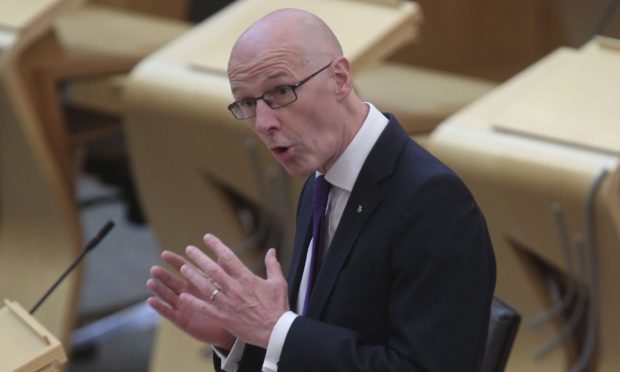John Swinney has urged caution as schools begin their phased return to ensure case numbers do not “gallop away from us” again.
The education secretary discussed the phased return of P1-3s and said it would be under constant review to ensure any potential spreading of the virus is stamped out quickly.
On BBC’s Good Morning Scotland Mr Swinney said: “We will be looking at a range of data, but principally case prevalence data, which shows the levels of the virus across the whole population and individual age groups.
“We will be able to see if there is any changes as we look very closely at outbreaks in institutional settings on a daily basis.”
Parents urged not to drop their guard as Scotland’s youngest pupils make return to classrooms today
The deputy first minister insisted that today’s decision was safe and based on information by advisory groups that show “sizable differences” in the prevalence of the virus in younger age groups.
However he urged parents and carers to obverse all limitations and restrictions to suppress community transmissions of the virus when congregating outside school gates.
He continued: “Community transmissions of the virus is the biggest threat to the opening of schools and expanding that in the weeks and months.
“We do not want to see this virus gallop away from us again.
“That is why we are treading with such caution, why we are taking the steps we are taking today about schooling and care home visiting.
“These are the issues of greatest priority.”
‘I want to get children back into classrooms as soon as we can’
Today’s decision was supported by shadow education secretary Jamie Greene, who said he was keen to see more youngsters back in the classroom soon.
He said: “I support the principle of a phased approach and welcome that some children are going back to school today – a relief to many parents.
“I want to get children back into classrooms as soon as we can.”
Covid: Road map out of lockdown will be slow but changes are on the cards
He also stretched his thanks to teachers for doing a great job to deliver education in difficult circumstances.
However, the MSP questioned the government’s handling over the wider easing of lockdown measures with people “still in the dark”.
He said: “We were told from early days, lockdown restrictions we were facing in society were absolutely necessary to facilitate the return to school.
“The reality is that most of us have been in severe lockdown for a number of months already.
“I think it is fair to probe the government on their decisions and how we can get children back into the classroom because that’s where the best learning takes place.”
All pupils could be back in school before the summer
John Swinney also suggested that all pupils could make a return to school before the end of this academic year during a BBC interview yesterday.
He dismissed suggestions that full-time lessons for all children would be delayed until September, saying that authorities want to follow the effects of the limited classroom re-opening first, to make sure it’s then safe to get other pupils back to school.
John Swinney: Scottish pupils could be back in class before the end of this school year
Mr Swinney said the Scottish Government needs to “tread with great care” and that the respective administrations in Scotland and England have to make their own decisions around education based on the evidence available to them.
